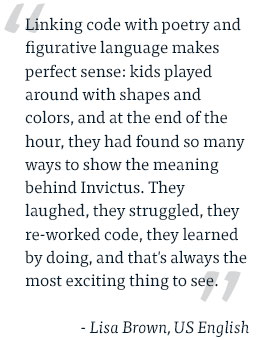Anybody can learn to code is the mantra of Code.org and it became ours on the morning of December 9, 2013. From 9 to 10 a.m., teachers across all disciplines led students through various tutorials and activities that connected their specific course content to coding. Simultaneously, teachers worldwide worked in a similar fashion to highlight not only the significance of coding in today’s world but the practicality (and necessity) of it.
While December 9 represented a synchronized effort to coordinate the entire school’s coding experience, it was not the first time Beaver students and teachers implemented code into their classes. Visual Arts teacher, David Ingenthron, worked with students during the first term on developing their portfolios. When one student asked if he could incorporate designs he composed using Pencilcode.net, David said “of course” and also asked the student to demonstrate his work to the class and help facilitate a lesson that inspired his peers to code and design alongside him. The final products were quite surprising. Here is one example: Swirly Thing.
Similarly, in Joe Christy’s math class, students not only engaged in coding from a math perspective but also coded data that was not exclusive to a “calculus specific” course (i.e. Wiretapping). By allowing coding to live outside of its stereotypical comfort zones of math and science, students at Beaver are able to not only learn the mechanics of a coding language but create and imagine new possibilities for coding.
So what exactly did teachers do on December 9?
Many members of the faculty started at the very beginning for their students with questions such as:
- What is coding?
- What are some coding languages?
- Where do we see coding today?
- Why do people code?
- Why does Beaver code?
These conversations set a context for the hour of code, generated ideas, and provided insights for the teacher on how exactly to implement and differentiate the coding activities that were about to follow. A number of teachers used tutorials provided by the Khan Academy for the day of coding, including tutorial I and tutorial II. Josh Rilla in the English Department experimented with “Codetry” — coding + poetry. In Visual Arts, teachers used Pencil Arts to design line drawings and challenged students to reflect on incorporating coding into their creative process. In Performing Arts, teachers used both activities from Khan Academy and Code.org.
I n the Middle School, Yolanda Wilcox-Gonzalez, Michelle Wildes, and Kathleen Kosberg turned the Hour of Code into a full day of coding by combining their history, science, and English 8th grade classes. They started the day by introducing the kids to what coding was and had them use the tutorials provided by Khan Academy. During the next two classes, they provided two challenges, one that was history-English related and the other related to science. For history/English, students had to code a program that allowed them to create an Infographic showing statistical data of the migration of Puerto Ricans and Polish people to the United States from 1879 until 1970.
n the Middle School, Yolanda Wilcox-Gonzalez, Michelle Wildes, and Kathleen Kosberg turned the Hour of Code into a full day of coding by combining their history, science, and English 8th grade classes. They started the day by introducing the kids to what coding was and had them use the tutorials provided by Khan Academy. During the next two classes, they provided two challenges, one that was history-English related and the other related to science. For history/English, students had to code a program that allowed them to create an Infographic showing statistical data of the migration of Puerto Ricans and Polish people to the United States from 1879 until 1970.
Students are currently reading West Side Story in English class and by giving students an idea about the migration of these two groups into the United States, the teachers provided background knowledge of the experience for each group while also exposing them to practical and authentic coding. In science, Michelle taught students about ocean organisms and students created codes for programs in which they drew and animated one of the ocean organisms they studied (fish, turtle, whale, shark, sea star, jelly, lobster). Here are a few examples of student work: Ben – Fish, Ryan – Sea Urchin, Kalala – Immigration.
It was clear after my own hour of code that once the students overcame their initial hesitancy around “doing it right” and just dove in, they were willing to play with coding, make mistakes, and rework their understanding, initial goals, and outcomes. The students that started at the very beginning with a simple drawing of a square were proud of their accomplishments and eager to push further into coding and brainstormed excitedly about how they could use coding again.
It was an excited morning as students from 6th through 12th grade grappled with coding, created something new, and challenged themselves and their teachers to think critically on how to make coding an authentic and consistent part of everyday.
Written by Melissa Alkire & Yolanda Wilcox-Gonzalez, Beaver’s Tech Integration Specialists.
Melissa teaches US History and Yolanda teaches MS History.
